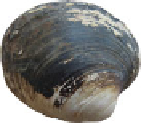Geoscience Reference
In-Depth Information
environmental data prior to the instrumental era in order to improve and verify such
climate models. Therefore, climate sciences rely on climate archives such as
sediment cores and ice cores. Such archives contain
, i.e. physical,
chemical or biological properties that correlate to certain environmental parameters
and hence allow reconstructions of such parameters at the time of the formation of
the archive. The relationship between water temperature and
“
proxies
”
18
O is thought to be
the most important relationship between an environmental parameter and its proxy.
Accretionally growing hard parts of aquatic organisms (e.g., corals,
δ
sh and
squid otoliths, coralline algae, bivalve shells) are being used as climate archives
intra-annual
decadal
Check for alterations:
Raman
microscopy
Correlation
or
Frequency
analysis
Seasonality:
oxygen isotopes
δ
Multi Taper Method
18
O
annual cyclicity
5-year signal
2
2
1.0
0.8
1
1
0.6
0.4
0
0
50
100
50
100
0.2
0
0
sample number
sample number
0
0
0.1
0.2
0.3
0.4
0.5
Frequency (1/yr)
Fig. 1 Flow chart illustrating potential reconstruction techniques on various time-scales for
bivalve shells. Geochemical analyses, such as
18
O as a proxy for water temperatures, allow
reconstructions on an intra-annual level. A test for preservation in fossil specimens
δ
—
e.g., by using
CRM
should be obligatory. The shell of A. islandica can additionally be used for a frequency
analysis (e.g., Multi Taper Method) of the annual growth pattern, allowing the identi
cation of
decadal variabilities, such as a 5-year quasi-periodic signal
—




































































Search WWH ::

Custom Search